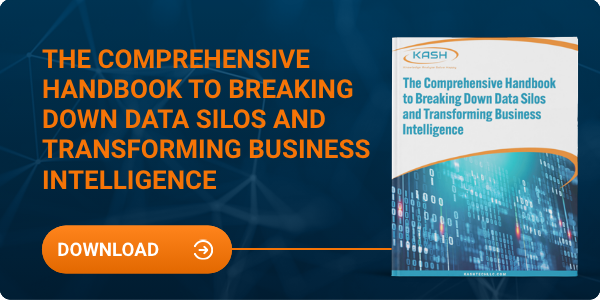3 Critical Factors that Transform a Business into a Profitable, Data-Driven Organization
Topic:
Data Silos
Transforming your business into a data-driven organization is not just about picking the ‘right’ technology. It is about creating cultural change throughout the company. The technology part focuses on the characteristics of a data-driven culture as a roadmap to making informed decisions guided by facts and not just gut instinct. However, cultural change requires positive management attitudes and behavior toward the investment of time and resources to achieve real change.
As Gartner says: “Data can only take an organization so far. The real drivers are people.”
So, a data-driven organization must start with the support of the senior management team with adherence to the proposition that all business decisions must be anchored in data.
About this Post
This post focuses on the “real drivers” of cultural change that can transform your business into a profitable data-driven organization.
First, we will cover the primary goals of data transformation and the studies that support their adoption.
Next, we will discuss three critical factors in transforming a business into a profitable data-driven organization:
- The common characteristics of successful data-driven companies
- The importance of internal advocacy in implementing the required technology solutions
- Why tearing down the obstacles of disjointed data silos is vital to transforming a business into a data-driven business culture
Finally, we will cite two successful data-driven organization examples employed by the music giant Spotify and the department chain Nordstrom.
The Primary Goals of Data Transformation
The primary goals in digital business transformation are:
- achieving better outcomes (increasing profitability, customer satisfaction, etc.)
- creating better efficiencies (generating products and services with optimal return on investment)
Both of the above rely on creating more efficient management and utilizing your organization’s vast data sources. Many businesses continue to utilize legacy methods to analyze their data but fail to optimize the production or delivery of valuable analytics. In fact, industry experience and studies by the McKinsey Global Institute show that:
- data-driven companies have a 23-times better chance of selling simply because they have more data about their customers and their issues
- businesses are 19 times more likely to achieve higher profits through data transformation.
Data virtualization, for example, leverages the cloud to handle the ever-growing volume and variety of data sources streaming into the organization. You can read more about transcending the limitations of traditional data integration methods in the Denodo eBook, “Data Virtualization for dummies.”
3 Key Factors in Creating a Successful Data-Driven Organization
Critical Factor 1: Common Characteristics of Data-Driven Companies
Successful data-driven companies share some common characteristics. They include:
- a well-defined strategy to enable data-driven tactics
- a clear pathway to achieve the intended results
- well-defined short- and long-term goals
- investment in the right technologies, skills, and talent
The preceding characteristics are predicated on an effective data-driven culture that is intentional and driven by senior management. Leaders’ attitudes and actions must demonstrate a relentless insistence that decisions must be anchored in data.
An essential aspect of creating a culture of data transformation is educating the employees on the value of becoming more data-driven in their day-to-day work. People working for the company must buy into data transformation initiatives, know why they are being implemented, and appreciate how those initiatives will help them to contribute to the company’s success.
Critical Factor 2: Promoting Internal Advocacy in Implementing Technology
The key to overcoming resistance to change is to make it easier for users to do what you want them to do rather than what they want to do.
The best technology solution/platform requires internal advocates (trainers, dedicated users, etc.) who can develop the best business use cases and demonstrate how the technology can boost innovation and create better results for the company—and how departmental data silos must be abandoned or integrated into the realm of a company-wide master data management solution.
- The technology solutions must be based on the following:
- The data must be trusted and accessible across the organization.
- Emphasis must be on putting automated processes in place to organize the data into a single source of truth.
- The organization must invest in the right self-service tools that support new technologies such as:
- AI-driven insights
- cloud-based data
- data virtualization
- augmented analytics
- AI-driven insights
The above technologies support a culture where data is easily accessible; insights are shared, and—this bears repeating—there is trust in the data across the organization’s culture.
Finally, this Harvard Business Review quote encapsulates the idea perfectly: “Persistence, resilience, execution, and a relentless drive to employ data to make more informed business decisions distinguish companies that prevail from those that continue to struggle.”
Critical Factor 3: Tearing Down the Obstacles of Data Silos
Our blog titled “The Best Method For Eliminating Data Silos In Your Organization” discusses the tendency in most organizations to maintain data in disjointed silos. Data silos, unfortunately, provide a critical roadblock to many data transformation efforts.
Compounding the problem is that legacy data integration approaches lack the automation and scalability to keep pace with the rapid growth and changes in the data landscape. That, in turn, makes it challenging to integrate, analyze, and share data efficiently.
To address the problem of data silos, companies need to create a data strategy that:
- encompasses an end-to-end architecture
- employs a management approach that addresses the elimination of data silos and democratizes data across the organization
- makes the data more accessible and consistent for everyone
Today this is referred to as a data fabric. The value of the data fabric is that it connects all data sources, whether stored in-house or in the cloud. This provides data consistency and governance at a lower cost than traditional technologies and data management processes.
Read more about the importance of eliminating data silos. Download our eBook “The Comprehensive Handbook: Breaking Down Data Silos & Transforming Business Intelligence.”
Examples of Data-Driven Organizations
Below are two examples of how businesses use data transformation to drive success and improve customer management:
The Spotify platform tracks and captures users' behavior (music selections and preferences). Spotify uses this data to push listening recommendations for playlists. The customer no longer has to browse thousands of musical choices. Instead, Spotify sends the customer a personalized list of suggested music choices.
Nordstrom has installed WiFi in their brick-and-mortar stores to track the customer’s location in the store. Depending on the customer’s purchasing history and where the customer is at the time of the shopping visit, Nordstrom sends the customer product information, sales specials, and promotions for upselling.
The foregoing are prime examples of enhancing personalized customer engagement. That engagement increases customer retention and the adding new customers.
Summary Point
Data transformation is a continuous improvement process. It doesn’t have an end-point. Accordingly, successful data transformation requires a culture change across the organization and an investment of people, time, and money.
Take a deep dive into data silos by downloading our handbook: The Comprehensive Handbook to Breaking Down Data Silos & Transforming Business Intelligence.
